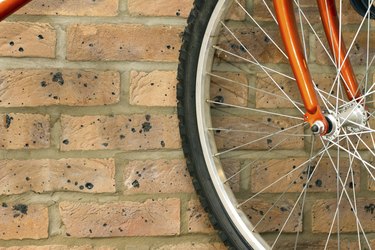
When the weather turns sour many bicyclists retire their machines to wait for the next season. For those cyclists who want to continue riding in the off-season, an indoor bike trainer is a solid option to stay in shape. In general, bike trainers are very safe to use on bicycles, even very expensive carbon fiber bikes. However, there are a few ways to damage your bicycle and its components with a trainer.
Resistance Trainers
Video of the Day
Resistance trainers come with several different kinds of resistance. Some use wind resistance, others use fluid or magnets, or sometimes a combination of the two. Resistance trainers contact your bike in two places; the rear tire and the rear hub. The connection at the hub keeps the bike in place. The tire comes in contact with the resistance wheel that determines how easy or hard it is for you to pedal.
Video of the Day
Rollers
Rollers are another type of indoor bike trainer. You can get them with resistance, but in general it is not standard equipment. Unlike more traditional resistance trainers, rollers do not contact your rear hub. Rather, they contact both rear and front tires. Rollers are like a treadmill for bicycles. There is no device to hold the bike in place. You stay up by maintaining your balance, simulating real riding conditions. Rollers are more difficult to get used to, but they provide a more realistic indoor training experience.
Damage
With resistance trainers, it is important not to over-tighten the connection on the rear hub. Test the connection by spinning the wheel after you have tightened the trainer to the hub. The wheel should spin freely. If it does not spin freely, you have over-tightened the trainer to the hub and are compressing the hub bearings, which can lead to significant damage if you ride on it. Another type of damage your bike can undergo in a trainer is increased tire wear on the rear tire for resistance trainers and on both tires for rollers. Lastly, if you tend to sweat a lot during your indoor bike trainer sessions, the sweat can drip over the bike's components and corrode them because of sweat's salt content.
Considerations
To reduce the wear and tear on your bike when using an indoor trainer, take a few precautions. Consider getting a trainer tire for your rear wheel. You do not want to wear through expensive tires with your trainer, especially when tread styles and weight do not matter. For those who sweat during training, place a towel over the top tube of the bicycle to protect the components and always wipe the bike down after you are done training.